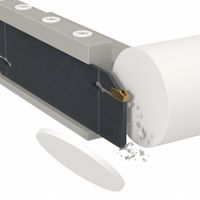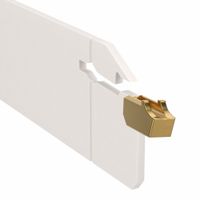Call +(254) 703 030 000 / 751 483 999 / 721 704 777
- Home
- Machining
- Indexable Cutting Tools
- Indexable Parting Grooving
.....Read More
Frequently Asked Questions
What are indexable parting and grooving tools?
Indexable parting and grooving tools are specialized cutting tools used in machining operations to separate (part) or create grooves in a workpiece. These tools are characterized by their use of replaceable cutting inserts, which are clamped onto a tool holder. The inserts are typically made from materials like carbide, ceramic, or cermet, providing durability and heat resistance.
The term "indexable" refers to the ability to rotate or flip the cutting insert to a new cutting edge once the current edge becomes worn, without the need to remove the insert from the holder. This feature enhances tool life and reduces downtime, as operators can quickly change the cutting edge without regrinding or resetting the tool.
Parting tools are used to cut off a section of a workpiece, often in lathe operations. They are designed to make narrow cuts, minimizing material waste and reducing cutting forces. Grooving tools, on the other hand, are used to create grooves or recesses in the workpiece surface. These grooves can be for functional purposes, such as accommodating O-rings or retaining rings, or for aesthetic reasons.
Indexable parting and grooving tools come in various designs to accommodate different applications, including straight, angled, or form tools. The tool holders are engineered to provide stability and precision, often featuring coolant channels to enhance chip evacuation and reduce heat buildup.
Overall, indexable parting and grooving tools offer significant advantages in terms of efficiency, cost-effectiveness, and versatility, making them essential in modern manufacturing processes.
How do indexable inserts work in parting and grooving tools?
Indexable inserts in parting and grooving tools work by providing a replaceable cutting edge that can be easily swapped out when worn or damaged, without the need to replace the entire tool. These inserts are typically made from hard materials like carbide, ceramics, or cermets, which offer high wear resistance and durability.
The inserts are designed with specific geometries to optimize cutting performance, including rake angles, chip breakers, and clearance angles. These features help in reducing cutting forces, controlling chip formation, and minimizing heat generation, which are critical in parting and grooving operations.
The inserts are mounted onto a tool holder, which securely clamps them in place. The tool holder is designed to provide stability and support to the insert, ensuring precise and consistent cutting. The clamping mechanism often allows for quick and easy insert changes, minimizing downtime.
In parting operations, the insert is used to cut off a section of material, typically from a rotating workpiece. The insert's geometry is crucial for achieving a clean cut and preventing tool deflection. In grooving, the insert creates a channel or groove in the workpiece, and the insert's design helps in maintaining the desired groove dimensions and surface finish.
Indexable inserts offer several advantages, including cost-effectiveness, as only the insert needs replacement rather than the entire tool. They also provide flexibility, as different inserts can be used for various materials and applications. Additionally, they contribute to improved productivity and efficiency in machining operations by allowing for higher cutting speeds and feeds.
What are the benefits of using indexable tools over solid tools?
Indexable tools offer several advantages over solid tools:
1. **Cost Efficiency**: Indexable tools have replaceable inserts, reducing the need to replace the entire tool. This lowers the cost per part and minimizes inventory requirements.
2. **Versatility**: They can be used for a variety of operations by simply changing the insert, making them adaptable to different materials and cutting conditions.
3. **Reduced Downtime**: Quick insert changes minimize machine downtime, enhancing productivity. Operators can replace inserts without removing the tool from the machine.
4. **Consistent Performance**: Indexable inserts are manufactured to precise standards, ensuring consistent cutting performance and surface finish.
5. **Material Optimization**: Inserts are made from advanced materials like carbide, CBN, or PCD, offering superior wear resistance and heat management compared to solid tools.
6. **Improved Tool Life**: The ability to rotate or index inserts allows for the use of multiple cutting edges, extending the tool's life.
7. **Enhanced Cutting Parameters**: Indexable tools can operate at higher speeds and feeds, improving machining efficiency and reducing cycle times.
8. **Environmental Benefits**: Less material waste is generated since only the insert is replaced, not the entire tool.
9. **Design Flexibility**: Manufacturers can design complex geometries and chip breakers on inserts, optimizing them for specific applications.
10. **Inventory Management**: A single tool body can accommodate various inserts, simplifying inventory and reducing storage space.
11. **Safety**: The ease of changing inserts reduces the risk of injury compared to regrinding or replacing solid tools.
Overall, indexable tools provide a flexible, cost-effective, and efficient solution for modern machining operations.
How do you choose the right indexable insert for a specific material?
To choose the right indexable insert for a specific material, consider the following factors:
1. **Material Type**: Identify the material being machined (e.g., steel, stainless steel, cast iron, non-ferrous metals, or superalloys). Each material has specific properties that affect machinability.
2. **Insert Material**: Select the insert material based on the workpiece material. Common insert materials include carbide, cermet, ceramic, CBN (Cubic Boron Nitride), and PCD (Polycrystalline Diamond). Carbide is versatile, while ceramics and CBN are suitable for hard materials.
3. **Coating**: Choose the appropriate coating to enhance wear resistance and tool life. Common coatings include TiN (Titanium Nitride), TiCN (Titanium Carbonitride), and Al2O3 (Aluminum Oxide). Coatings reduce friction and improve heat resistance.
4. **Insert Geometry**: Consider the insert shape, size, and edge preparation. Positive rake angles reduce cutting forces, while negative rake angles offer strength. The nose radius affects surface finish and tool strength.
5. **Cutting Conditions**: Match the insert to the cutting speed, feed rate, and depth of cut. High-speed operations may require inserts with better heat resistance, while heavy cuts need robust inserts.
6. **Machine Tool Capability**: Ensure the insert is compatible with the machine's power, rigidity, and spindle speed.
7. **Application**: Consider the type of operation (e.g., turning, milling, drilling) and the desired surface finish and dimensional accuracy.
8. **Cost and Availability**: Balance performance with cost-effectiveness and ensure the insert is readily available.
9. **Manufacturer Recommendations**: Consult tool manufacturers' catalogs and guidelines for specific recommendations based on extensive testing and application data.
By evaluating these factors, you can select an indexable insert that optimizes performance, tool life, and cost for the specific material and machining operation.
What maintenance is required for indexable parting and grooving tools?
Maintenance for indexable parting and grooving tools involves several key practices to ensure optimal performance and longevity:
1. **Regular Inspection**: Frequently check the tool for wear, damage, or chipping on the cutting edges. Inspect the toolholder and insert seat for any signs of wear or damage that could affect tool stability and performance.
2. **Insert Replacement**: Replace inserts when they become dull or damaged. Ensure that the new inserts are compatible with the toolholder and are correctly seated to prevent misalignment and potential tool failure.
3. **Toolholder Maintenance**: Clean the toolholder regularly to remove any chips, debris, or coolant residues. This prevents buildup that can affect the tool's performance and accuracy. Check for any signs of wear or damage and replace the toolholder if necessary.
4. **Coolant System Check**: Ensure the coolant system is functioning properly to prevent overheating and extend tool life. Check for blockages in coolant nozzles and ensure the coolant is clean and at the correct concentration.
5. **Alignment and Setup**: Verify that the tool is correctly aligned and set up in the machine. Misalignment can lead to uneven wear and tool breakage. Use appropriate gauges and alignment tools to ensure precision.
6. **Torque Specifications**: Use the correct torque settings when mounting inserts and toolholders. Over-tightening can cause damage, while under-tightening can lead to insert movement during operation.
7. **Storage**: Store tools and inserts in a clean, dry environment to prevent corrosion and damage. Use protective cases or racks to avoid accidental damage.
8. **Documentation**: Keep records of tool usage, maintenance activities, and any issues encountered. This helps in tracking tool performance and planning maintenance schedules.
By adhering to these maintenance practices, the efficiency and lifespan of indexable parting and grooving tools can be significantly enhanced.
How do you properly set up and align indexable parting and grooving tools on a lathe or CNC machine?
To properly set up and align indexable parting and grooving tools on a lathe or CNC machine, follow these steps:
1. **Tool Selection**: Choose the appropriate tool holder and insert based on the material and dimensions of the workpiece. Ensure the insert is sharp and in good condition.
2. **Tool Holder Installation**: Secure the tool holder in the lathe's tool post or turret. Ensure it is tightly clamped to prevent movement during operation.
3. **Center Height Alignment**: Align the cutting edge of the tool with the centerline of the workpiece. Use a center height gauge or a ruler to ensure the tool is neither above nor below the centerline, as misalignment can cause poor surface finish or tool breakage.
4. **Tool Perpendicularity**: Ensure the tool is perpendicular to the workpiece. Use a square or a dial indicator to check that the tool holder is at a 90-degree angle to the workpiece axis.
5. **Insert Positioning**: Position the insert so that it is fully supported by the tool holder. The insert should protrude just enough to perform the cut without excessive overhang, which can lead to vibration and deflection.
6. **Tool Offset Setting**: Input the correct tool offset in the CNC machine's control system. This ensures the machine knows the exact position of the tool tip relative to the workpiece.
7. **Coolant and Chip Evacuation**: Set up appropriate coolant flow to reduce heat and improve tool life. Ensure there is a clear path for chip evacuation to prevent re-cutting and tool damage.
8. **Test Cut and Adjustments**: Perform a test cut and inspect the results. Make any necessary adjustments to the tool position or machine parameters to achieve the desired cut quality and dimensions.
9. **Regular Checks**: Periodically check the tool alignment and condition during operation to maintain optimal performance.
What are common issues and troubleshooting tips for indexable parting and grooving tools?
Common issues with indexable parting and grooving tools include:
1. **Tool Breakage**: Often caused by incorrect feed rates, excessive cutting speeds, or improper tool setup. Ensure the tool is aligned correctly and use recommended cutting parameters.
2. **Poor Surface Finish**: Can result from tool wear, incorrect cutting speed, or vibration. Regularly inspect and replace worn inserts, adjust speeds, and ensure the tool is rigidly clamped.
3. **Insert Chipping**: Typically due to excessive feed rates or interrupted cuts. Use appropriate feed rates and ensure a smooth, continuous cut.
4. **Vibration and Chatter**: Caused by insufficient tool support or incorrect cutting parameters. Use a stable setup, reduce overhang, and adjust speeds and feeds to minimize vibration.
5. **Built-up Edge (BUE)**: Occurs when material adheres to the cutting edge, often due to incorrect cutting speeds or inadequate lubrication. Use proper cutting fluids and adjust speeds to reduce BUE.
6. **Tool Deflection**: Results from excessive tool overhang or incorrect clamping. Minimize overhang and ensure the tool is securely clamped.
Troubleshooting Tips:
- **Check Tool Alignment**: Ensure the tool is perpendicular to the workpiece to prevent uneven wear and breakage.
- **Optimize Cutting Parameters**: Follow manufacturer recommendations for speeds and feeds based on material and tool type.
- **Regular Maintenance**: Inspect tools and inserts regularly for wear and damage, replacing them as needed.
- **Use Proper Coolant**: Apply adequate coolant to reduce heat and improve tool life.
- **Secure Workpiece**: Ensure the workpiece is firmly clamped to prevent movement during cutting.
- **Monitor Tool Wear**: Use wear indicators or regular inspections to replace tools before failure occurs.



